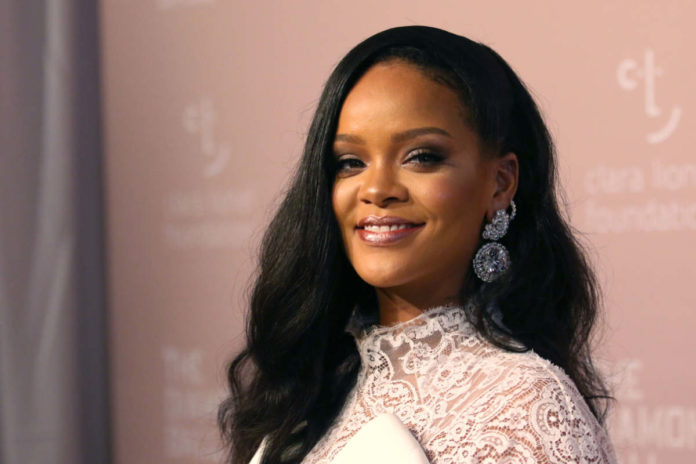(Bloomberg) — Victoria’s Secret, amid an identity crisis over its antiquated view of female beauty, is taking a step back to re-evaluate what to do with its annual fashion show. For guidance on how to proceed in the post-supermodel era, the company might want to take a look at Rihanna’s show on Sept. 10 at the Barclays Center in Brooklyn.
Sure, there were plenty of stiletto-clad models to promote her Savage X Fenty lingerie brand—some of whom have participated in past Victoria’s Secret events as well. But unlike those shows, Rihanna’s featured women of all shapes and sizes. The models were racially diverse, as well, representing nearly all the shades offered by Rihanna’s Fenty makeup line.
Read: Why Luxury Fashion Is Walking the Runway in Recycled-Plastic Heels
On the same day as the show in Brooklyn, Les Wexner—the billionaire founder of Victoria’s Secret parent company, L Brands Inc.—convened with investors in Columbus, Ohio, where a series of mostly male executives laid out plans to win back market share that’s been lost to upstart rivals like Savage X Fenty.
Victoria’s Secret is in the initial stages of recasting its advertising: For now, it’s producing more black-and-white photos with a retro aesthetic and stylized videos touting product partnerships. The company says it will also produce better quality lingerie, improve in-store experience and focus on “By Her, For Her,” according to Victoria’s Secret Lingerie Chief Executive Officer John Mehas.
Read: Calvin Klein to Eliminate High-End Runway Fashion Collection
But as L Brands moves tentatively forward, Rihanna and other competitors like Aerie and ThirdLove Inc. have their message nailed down. It’s built on inclusivity and diversity, and it’s letting them jump in and flood the neglected spaces in the market. Victoria’s Secret U.S. market share now stands at 24%, according to Coresight Research, down from almost 32% in 2013.
Savage X Fenty isn’t just gaining ground with more diverse models. The product offerings it showcased on the runway were diverse as well. The message that intimate apparel can be functional, as well as alluring, is resonating.
Read: Online Fashion Thrives for New Retailer Where Women Call Shots
While Victoria’s Secret hasn’t publicly canceled its 2019 show, executives said in May it wouldn’t be broadcast on TV for the first time in more than two decades, following years of viewership declines. In 2018, the show drew its smallest-ever audience of just 3.3 million viewers, down from more than 5 million the year before. That, in turn, is down from a 2011 broadcast where nearly 10.3 million people tuned in.
Asked about plans for this year’s show, an L Brands spokeswoman referred to comments from Mehas during the investor event. “We’ve also made some recent marketing changes,” he said on Sept. 10. “We’re re-evaluating the fashion show. We are taking time to evaluate the right marketing strategy going forward.”
Rihanna’s show, in contrast, will be available to Amazon Prime’s more than 100 million subscribers on Sept. 20. A Nielsen study shows the median age of viewers for digital services like Prime is 40, younger than broadcast TV viewers and closer to Victoria’s Secret target of women in their early 30s.
Razek, who left Victoria’s Secret in August, also said when the company tried to do a television special for plus-size models in the early 2000s that “no one had any interest in it, still don’t.” Rihanna’s show went beyond a token plus-size model and featured many women of different sizes and abilities, including a model with prosthetic legs. Last year’s show had a pregnant model who went into labor right after the event.
Victoria’s Secret still holds the most market share in the $13.1 billion U.S. women’s underwear sector—a fact that L Brands Chief Financial Officer Stuart Burgdoerfer highlighted on Tuesday. But its nimble adversaries continue to gain ground.
“These brands are losing customers and pricing power while competition is increasing,” said Jefferies analyst Randal Konik in a research note about L Brands titled “Don’t Buy the `Sexy Illusion.’” While it’s good that management has acknowledged that change is needed, “consumer perceptions of brands are hard to change,” he said.
When it comes to investment, the upstarts are making their presence felt: Savage X Fenty announced a $50 million funding round earlier this month. ThirdLove, an online lingerie seller, recently opened its first pop-up shop this summer in Manhattan’s SoHo district after raising $55 million earlier this year. Meanwhile, L Brands shares have fallen 26% this year, compared with a 20% gain for the S&P 500 index.
Victoria’s Secret is aware of the challenge. As its CEO Mehas said: “There’s a big belief in the company that we need to evolve.”





